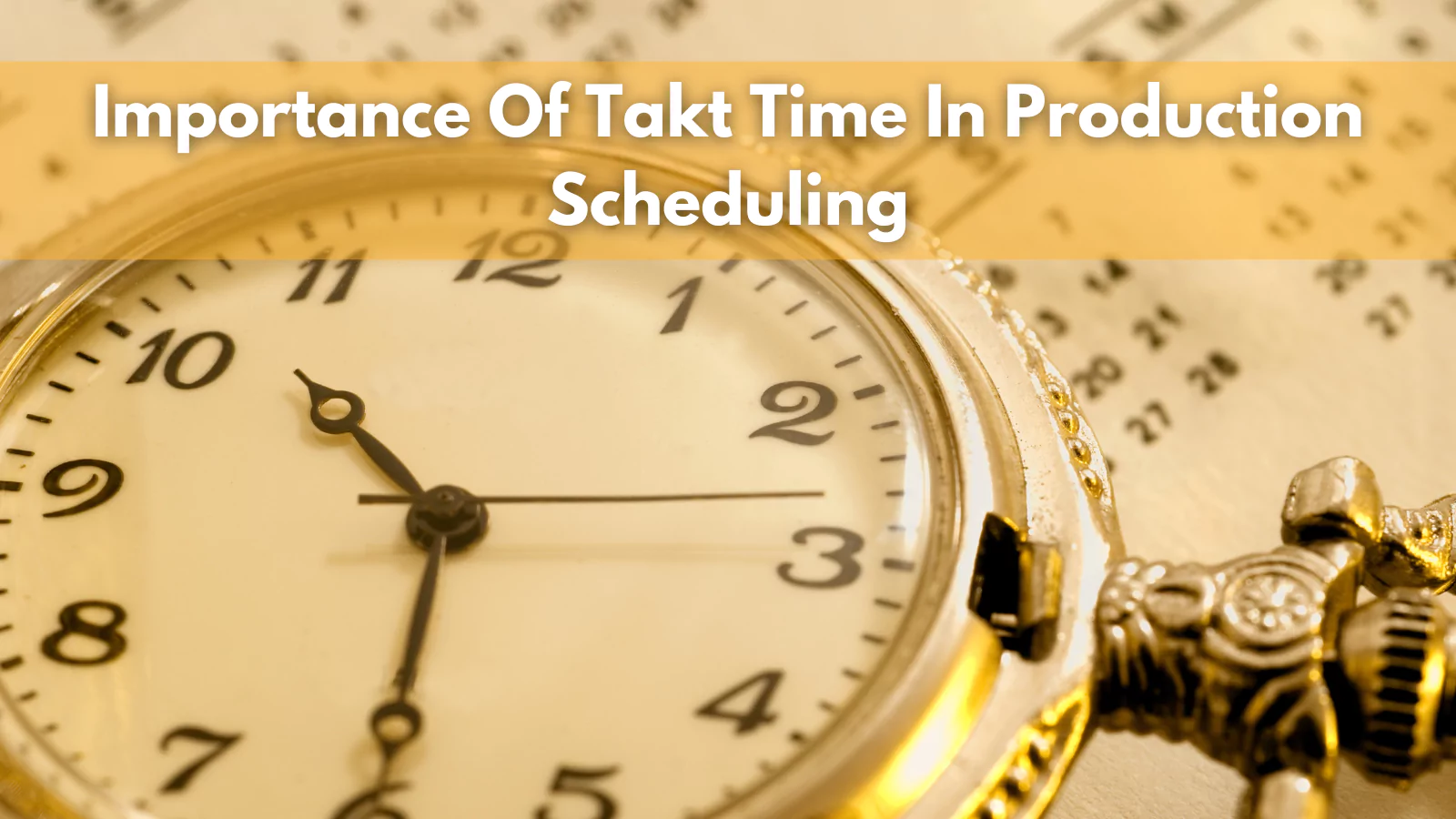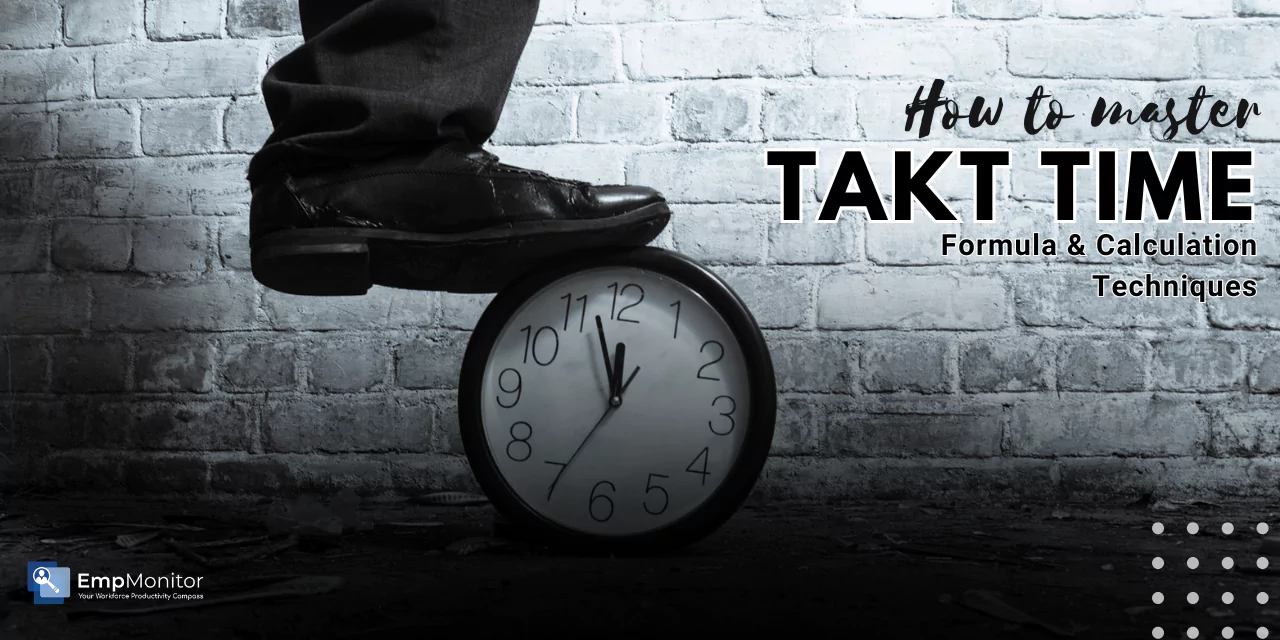In today’s manufacturing environment, efficiency and precision are paramount. Businesses constantly seek ways to optimize their production processes to stay competitive and meet ever-evolving customer demands. One critical concept that helps companies to achieve these goals is takt time.
Takt time is the heartbeat of a production line. It dictates the pace at which products must be manufactured to meet customer demand without overproduction or underproduction. By aligning production rates with customer needs, businesses can reduce waste, improve workflow, and ensure timely deliveries. This synchronization between production and demand is essential for maintaining a lean and efficient operation.
Understanding and mastering Production Pace can lead to streamlined production processes and better alignment with customer demands. When businesses accurately calculate and implement Production Pace, they can avoid bottlenecks, minimize idle time, and enhance overall productivity. It is a guiding metric that keeps production teams focused on meeting goals and maintaining consistent output.
In this blog, we’ll delve into the formula for calculating Production Pace and explore practical techniques to make the most of this valuable metric. By the end of this journey, you’ll have a comprehensive understanding of how Production Pace can revolutionize your production processes and drive your business toward greater efficiency and success. So, let’s dive into the world of takt time and discover the secrets to mastering this essential production tool.
In a hurry? Listen to the blog instead!
What Is Takt Time?

Production Pace is the key to maintaining efficiency in manufacturing, ensuring that output aligns with demand. By setting a structured pace, manufacturers can streamline operations, reducing excess inventory and eliminating waste—both crucial elements of lean production.
Beyond just balancing supply and demand, the Production Pace enhances overall workflow. It enables managers to optimize resource allocation, fine-tune scheduling, and establish realistic production goals. When all processes operate in sync with a well-defined pace, businesses can maintain steady productivity while improving customer satisfaction.
But how exactly is takt time calculated? To answer this question, we need to delve into the Production Pace formula and understand its components. This calculation is pivotal in determining the production pace that matches customer demand, and it’s simpler than you might think. Let’s explore the formula and break it down step by step.
The Takt Time Formula

Takt Time = Available Production/ TimeCustomer Demand
By understanding the components of this formula—available production time and customer demand—we can better grasp how Production Pace functions in practice. Now, let’s break down these components and see how they play a role in the calculation process.
Available Production Time
Available production time refers to the total time during which production can occur within a given period. It is essential to consider only when production is possible, excluding breaks, maintenance, and any other non-production activities. It ensures that the takt time calculation reflects the actual productive hours.
For instance, if a factory operates for 8 hours a day, but there are two 15-minute breaks and a 30-minute lunch break, the available production time would be:
8 hours − 1 hour of breaks = 7 hours
7hours×60minutes=420minutes
Customer Demand
Customer demand is the number of products that need to be made within the available production time. Accurately determining customer demand is crucial for an effective Production Pace calculation. This demand can be based on historical data, market forecasts, or current orders.
For example, if customers require 210 units per day, this number represents the customer demand.
Putting It All Together
By combining these components, we can calculate the Production Pace. Using our example, with 420 minutes of available production time and a customer demand of 210 units per day, the Production Pace would be:
Takt Time = Available Production /Time Customer Demand
Takt Time = 420 minutes /210 units
Takt Time = 2 minutes per unit
It means the production process needs to produce one unit every 2 minutes to meet customer demand efficiently. By adhering to this Production Pace, businesses can ensure a balanced and streamlined production flow.
With a clear understanding of the takt time formula, we can now move on to a step-by-step guide on how to calculate Production Pace for various scenarios. It will help you apply the formula effectively in different production environments.
How To Calculate Takt Time?

Step 1: Identify the Available Work Hours
The first step is to determine how much actual production time is available within a specific period, such as a day or week. It’s important to exclude any time spent on breaks, equipment maintenance, or meetings—only counting the hours that contribute directly to production.
For example, if your factory operates for 10 hours daily but includes two 20-minute breaks and a 40-minute lunch break, the total available time is:
10 hours – 1 hour (breaks) = 9 hours
9 hours × 60 minutes = 540 minutes
Step 2: Measure the Customer Demand
Next, determine how many units customers need within the same timeframe. This can be derived from past sales, market forecasts, or active orders. The accuracy of this step is essential, as overestimating or underestimating demand can lead to inefficiencies.
For instance, if customers require 270 units per day, this number becomes your target output.
Step 3: Calculate the Necessary Production Speed
Once you have both figures, use the Production Pace formula to calculate how quickly each unit should be produced:
Production Pace = Available Production Time ÷ Customer Demand
Using our example:
540 minutes ÷ 270 units = 2 minutes per unit
This means that to keep up with demand, the factory must produce one unit every 2 minutes.
Applying the Formula in Different Scenarios
To see how this works in different settings, let’s consider another case. Imagine a company operates for 12 hours daily, with three 30-minute breaks:
12 hours – 1.5 hours (breaks) = 10.5 hours
10.5 hours × 60 minutes = 630 minutes
If customer demand is 315 units per day, the Production Pace would be:
630 minutes ÷ 315 units = 2 minutes per unit
Following this structured approach ensures a smooth production flow, preventing overproduction while meeting demand efficiently.
Now that we’ve established how to determine the correct pace, let’s explore how it differs from cycle time, a key factor in optimizing production planning.
Takt Time vs. Cycle Time: Understanding The Differences

Production Pace: Setting the Production Pace
Production Pace is the rhythm or beat at which products need to be produced to meet customer demand. It is calculated by dividing the available production time by the customer demand.
Production Pace ensures that production rates are aligned with customer needs, preventing overproduction and underproduction. It acts as a guiding metric that helps manufacturers streamline their processes and maintain a consistent production flow.
For example, if a factory operates for 420 minutes a day and the customer demand is 210 units, the Production Pace would be 2 minutes per unit. It means that one unit should be produced every 2 minutes to meet customer demand efficiently.
Cycle Time: Measuring Actual Production Time
Cycle time, on the other hand, measures the actual time taken to complete one production cycle, from start to finish. It includes all activities involved in the production process, such as setup, processing, inspection, and handling. Unlike Production Pace, which sets a target pace, cycle time reflects the real-world performance of the production process.
For instance, if it takes an average of 2.5 minutes to produce one unit, this is the cycle time. It includes any delays or inefficiencies that occur during the production cycle.
Key Differences and Their Impact
Understanding the differences between takt time and cycle time is crucial for optimizing production schedules. While takt time helps set the desired pace of production to meet customer demand, cycle time provides insights into the actual performance and efficiency of the production process.
By comparing these two metrics, businesses can identify inefficiencies and make adjustments to improve overall productivity. For example, if the cycle time is longer than the Production Pace, the production process is not meeting the desired pace, leading to potential delays and customer dissatisfaction. In such cases, businesses can analyze the production process to identify bottlenecks, streamline workflows, and implement improvements to reduce cycle time.
Optimizing Production Schedules
This distinction between Production Pace and cycle time brings us to the importance of Production Pace in creating efficient production schedules. By aligning production processes with Production Pace, businesses can ensure that their operations are synchronized with customer demand, reducing waste and improving efficiency. Adjusting cycle time helps maintain this alignment and enhances overall production performance.
In the next section, we’ll explore the role of takt time in production scheduling and how it contributes to achieving a balanced and efficient workflow.
Importance Of Takt Time In Production Scheduling

Enhancing Production Efficiency
When production schedules are aligned with Production Pace, businesses can ensure a smooth and continuous workflow. By producing at the exact rate needed to meet customer demand, manufacturers can minimize downtime and prevent the accumulation of excess inventory. This synchronization leads to a more efficient use of resources, reducing operational costs and enhancing overall productivity.
Reducing Waste and Overproduction
Overproduction is a common issue in manufacturing that leads to increased storage costs, wasted materials, and reduced profitability. Production Pace helps businesses avoid these pitfalls by setting a clear production rhythm that matches demand. By adhering to this rhythm, companies can produce only what is needed, when it is needed, thereby reducing waste and improving inventory management.
Meeting Customer Demands
Production Pace ensures that production processes are aligned with customer demands. It enables businesses to deliver products on time and maintain high customer satisfaction. By consistently meeting demand, companies can build stronger relationships with their customers and enhance their market reputation.
Addressing Challenges In Implementation
Implementing the Production Pace isn’t without its challenges. Fluctuating customer demands, production bottlenecks, and workforce management issues can all impact the successful application of Production Pace. However, by closely monitoring production processes and making necessary adjustments, businesses can overcome these obstacles and achieve optimal results. Tools like EmpMonitor play a vital role in managing and monitoring these processes. With its advanced tracking, attendance management, and real-time performance analytics, EmpMonitor helps businesses ensure that their workforce is aligned with the production rhythm. This way, companies can achieve efficiency, improve employee performance, and meet production goals consistently.
EmpMonitor: Aiding Takt Time Implementation

- Real-Time Tracking: Monitor employee activities in real-time to ensure tasks are completed efficiently and deadlines are met.
- Detailed Reporting: Generate comprehensive reports on productivity metrics, helping managers identify strengths, areas for improvement, and workflow inefficiencies.
- Customizable Dashboards: Create personalized dashboards to track key performance indicators (KPIs) related to employee efficiency, providing actionable insights for decision-making.
- Performance Analysis: Analyze work patterns and performance trends to detect bottlenecks and optimize workload distribution for better productivity.
- Attendance Management: Track employee attendance accurately, including work hours, overtime, and absences, ensuring that attendance is aligned with performance expectations and business goals.
By leveraging these features, businesses can enhance employee performance, boost operational efficiency, and maintain a highly productive workforce.
Best Practices For Implementing Takt Time In Production

1. Conduct A Thorough Analysis
Before implementing Production Pace, conduct a comprehensive analysis of your current production processes. Identify areas where inefficiencies or bottlenecks occur, and assess how Production Pace can address these issues. This analysis will provide a solid foundation for making informed decisions and setting realistic production targets.
2. Engage And Train Employees
Employee engagement and training are crucial for successful Production Pace implementation. Ensure that all team members understand the concept of Production Pace, its importance, and how it affects their daily tasks. Provide training sessions and resources to help employees adapt to the new production rhythm and embrace a continuous improvement mindset.
3. Standardize Work Processes
Standardizing work processes is essential for maintaining consistency and achieving Production Pace targets. Develop standardized procedures for each production task, and ensure that all employees follow these procedures. This standardization helps minimize variability and ensures that production flows smoothly.
4. Use Visual Management Tools
Visual management tools, such as Production Pace boards, kanban boards, and production charts, can help monitor progress and keep everyone informed. Displaying real-time data on production status, Production Pace targets, and any deviations from the plan allows for quick identification of issues and prompt corrective actions.
5. Implement Continuous Improvement Practices
Continuous improvement is key to sustaining Production Pace implementation. Encourage employees to provide feedback and suggest improvements to the production process. Regularly review and analyze performance data to identify areas for enhancement. Implementing small, incremental changes can lead to significant improvements over time.
6. Monitor and Adjust Production Pace
Customer demand can fluctuate, and production processes may need to be adjusted accordingly. Regularly monitor Production Pace and make necessary adjustments to align with changing demands. Flexibility and adaptability are essential for maintaining efficiency and meeting customer expectations.
7. Leverage Technology and Tools
Utilize technology and tools to support Production Pace implementation. Productivity tracking and monitoring tools can provide valuable insights into production performance. Features like real-time tracking, detailed reporting, and customizable dashboards help businesses stay on track with their Production Pace goals and make informed decisions to optimize production processes.
Read More
9 Ways To Improve Employee Productivity In The Workplace
EFFICIENCY VS PRODUCTIVITY: HOW COULD IT BE IMPROVED?
Conclusion
Mastering the concept of takt time, or production pace, is essential for businesses aiming to enhance efficiency and meet customer demands. By understanding the formula, calculating the Production Pace accurately, and implementing best practices, companies can achieve a harmonious production flow that minimizes waste and maximizes productivity.
However, integrating takt time into production processes is just one piece of the puzzle. Effective productivity management is crucial to ensure that these efforts translate into tangible results. It is where tools like productivity tracking software and productivity monitoring come into play. By leveraging tools like empmonitor, businesses can gain real-time insights into their operations, identify areas for improvement, and make data-driven decisions to optimize their workflows.
Incorporating productivity tracking software allows for continuous monitoring and assessment of production activities, ensuring that Production Pace targets are consistently met. Through detailed reporting and performance analysis, businesses can pinpoint bottlenecks and implement corrective actions to maintain a smooth and efficient production pace.
FAQ Section
-
What industries commonly use production pace in their processes?
Production pace is widely used in various industries, including automotive manufacturing, electronics production, aerospace, healthcare, and even service industries. Any industry that aims to align production rates with customer demand can benefit from implementing production pace principles.
-
How can fluctuations in customer demand impact production pace?
Fluctuations in customer demand can significantly impact production pace. When demand increases, the production pace needs to accelerate, requiring a faster workflow. Conversely, when demand decreases, the production pace slows down. Businesses need to regularly monitor and adjust production pace to stay aligned with changing customer needs.
-
Can production pace be applied to service industries, or is it only for manufacturing?
Production pace can be applied to both manufacturing and service industries. In service industries, production pace can help standardize service delivery processes, improve efficiency, and ensure that customer needs are met promptly. For example, in healthcare, production pace can be used to streamline patient care processes.
-
How does production pace contribute to lean manufacturing principles?
Production pace is a fundamental component of lean manufacturing principles. By setting a production rate that matches customer demand, the production pace helps eliminate waste, reduce overproduction, and improve resource utilization. This alignment contributes to a more efficient and lean production process, ultimately enhancing overall productivity and quality.
-
What tools and technologies can assist in tracking and managing production pace?
Various tools and technologies can assist in tracking and managing production pace. Productivity tracking software, real-time monitoring systems, and performance analysis tools provide valuable insights into production processes. These technologies help businesses stay on track with their production pace goals, identify areas for improvement, and make data-driven decisions to optimize workflows.










